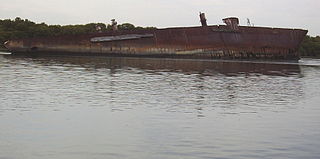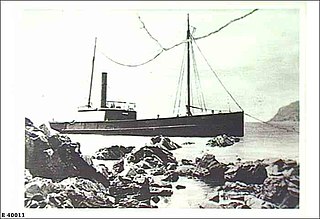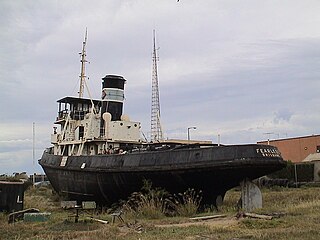
Whyalla was founded as "Hummocks Hill", and was known by that name until 1916. It is the fourth most populous city in the Australian state of South Australia after Adelaide, Mount Gambier and Gawler and along with Port Pirie and Port Augusta is one of the three towns to make up the Iron Triangle. As of June 2018, Whyalla had an urban population of 21,742, having declined at an average annual rate of -0.75% year-over-year over the preceding five years. It is a seaport located on the east coast of the Eyre Peninsula and is known as the "Steel City" due to its integrated steelworks and shipbuilding heritage. The port of Whyalla has been exporting iron ore since 1903.

Ardrossan is a town in the Australian state of South Australia located on the eastern coast of the Yorke Peninsula, about 150 kilometres (93 mi) by road from the Adelaide city centre. It is notable for its deepwater shipping port and its towering coastal cliffs of red clay.

One and All is a tall ship based in Adelaide, and rigged for twelve sails, which are controlled by 100 lines. After being launched in 1985, she took part in the First Fleet Re-enactment Voyage as part of Australia's bicentenary celebrations, travelling from Rio de Janeiro back to Australia. She was commonly used for sail training, offering courses and voyages that last from between a few hours to many weeks, especially for youth at risk. The vessel is run by registered not for profit group Friends of One and All Sailing ship Inc. and supported by volunteers and professional crew.

Port Noarlunga is a suburb in the City of Onkaparinga, South Australia. It is a small sea-side suburb, population 2,918, about 30 kilometres to the south of the Adelaide city centre and was originally created as a sea port. This area is now popular as a holiday destination or for permanent residents wishing to commute to Adelaide or work locally. There is a jetty that connects to a 1.6 kilometres long natural reef that is exposed at low tide. The beach is large and very long and has reasonable surfing in the South Port area whose name is taken from its location - "South of the Port".

City of Adelaide is a clipper ship, built in Sunderland, England, and launched on 7 May 1864. It was built by Pile, Hay and Co. to transport passengers and goods between Britain and Australia. Between 1864 and 1887 she made 23 annual return voyages from London and Plymouth to Adelaide, South Australia and played an important part in the immigration of Australia. On the return voyages she carried passengers, wool, and copper from Adelaide and Port Augusta to London. From 1869 to 1885 she was part of Harrold Brothers' "Adelaide Line" of clippers.

The 63 ton schooner Postboy was built at Port Adelaide in 1874. The schooner was owned by Messrs. Weman and Morgan and registered at Port Adelaide. She was a regular trading vessel between Port Adelaide and the gulf ports.

Falie is a 33.4-metre (110 ft) ketch that traded for many years in Australian waters. Originally built in 1919/1920 as a speculation by her builder, rigged as a schooner and named Hollands Trouw after the shipyard where she was built, she was purchased by the Spencer's Gulf Transport Company, renamed, and used for coastal trading in South Australia. The vessel was commissioned into the Royal Australian Navy (RAN) as HMAS Falie during World War II, serving first as an examination vessel primarily patrolling the Port of Sydney, Australia, then as an armed stores ship.

The Santiago was a 455-ton barque launched in 1856. It was built by Henry Balfour of Methil, Fife for the Liverpool shipping company Balfour Williamson. It sailed mainly between Liverpool and Chile, but also to Australia. Its remnant hull, which lies in a ships' graveyard in South Australia, is considered 'the oldest intact iron hull sailing vessel in the world.'

The Adelaide Steamship Company was an Australian shipping company and later a diversified industrial and logistics conglomerate. It was formed by a group of South Australian businessmen in 1875. Their aim was to control the transport of goods between Adelaide and Melbourne and profit from the need for an efficient and comfortable passenger service. For its first 100 years, the company's main activities were conventional shipping operations on the Australian coast, primary products, consumer cargoes and extensive passenger services.
Fort Largs is a historic defence site in the coastal suburb of Taperoo near Port Adelaide, South Australia, approximately 18 km (11 mi) north west of Adelaide's city centre.

Lucky Bay is a locality in the District Council of Franklin Harbour, on the Spencer Gulf coast of Eyre Peninsula in South Australia. It is a terminus for SeaSA's Spencer Gulf passenger ferry and a transshipping port for grain export operated by T-Ports. Lucky Bay is located immediately north-east of the Franklin Harbour wetlands. Its adjacent waters lie within the outer boundary of the Franklin Harbor Marine Park. A ferry service crossing Spencer Gulf from Lucky Bay to Wallaroo commenced in 2006, and the dirt road connecting Lucky Bay with the Lincoln Highway was sealed in 2008.

Yandra was a 990-ton coastal steamer built by Burmeister & Wain, Copenhagen in 1928 for Coast Steamships for service in the Australian state of South Australia. She was requisitioned by the Royal Australian Navy in June 1940 during World War II for conversion to a minesweeper and anti-submarine vessel and was commissioned on 22 September 1940 as HMAS Yandra. She returned to civilian service in 1946. She ran aground during dense fog onto South Neptune Island on 25 January 1959 and was subsequently written off.

Ellen was a steamship that was launched in 1883 and whose career involved coastal shipping firstly in the Colony of Queensland and then in the Australian state of South Australia. It was wrecked in Gulf St Vincent in South Australia at Morgan's Beach near the town of Cape Jervis on Saturday, 12 December 1908 during its return from fishing in waters around Kangaroo Island to a destination on the mainland.
Lipson Cove is a tranquil sandy bay in the Australian state of South Australia on the east coast of Eyre Peninsula overlooking Spencer Gulf. It features in the 2012 book 101 Best Australian Beaches by Andy Short and Brad Farmer.
Water Witch was a single-masted vessel rigged as a cutter built during 1835 in Van Diemen's Land and sunk in 1842 whilst moored in the River Murray at Moorundie, south of Blanchetown in South Australia (SA). Her wreck site was discovered in 1982 and received statutory protection as a historic shipwreck in 1983. The wreck site was the subject of an underwater survey in March 1984. She was the first European vessel to enter the River Murray via its mouth, her role in the charting of the lower reaches of the River Murray including Lake Alexandrina whilst under the command of William Pullen and her association with Edward John Eyre.

The South Australian Maritime Museum is a state government museum, part of the History Trust of South Australia. The Museum opened in 1986 in a collection of historic buildings in the heart of Port Adelaide, South Australia's first heritage precinct.
Transport in South Australia is provided by a mix of road, rail, sea and air transport. The capital city of Adelaide is the centre to transport in the state. With its population of 1.4 million people, it has the majority of the state's 1.7 million inhabitants. Adelaide has the state's major airport and sea port.

Yelta is a steam tug which operated in the Australian state of South Australia from 1949 to 1976 within both the Port River and the waters of Gulf St Vincent immediately adjoining the river's mouth. After being laid up for about nine years, she was purchased in 1985 by the Government of South Australia for addition to the collection of the South Australian Maritime Museum as a museum ship. As of 1985, she was considered to be the only remaining steam-powered tug operating within Australian waters.

Fearless is a tugboat that is located in Birkenhead, South Australia, Australia.

Garden Island is an island in the Australian state of South Australia located about 14 kilometres (8.7 mi) north-west of the capital city of Adelaide in an estuary system within the Adelaide metropolitan area which drains into Gulf St Vincent. It is notable as being a site for a mangrove forest, a landfill, a part of the site for the Multifunction Polis, a ship graveyard and a venue for recreational boating activities. It has enjoyed varying degrees of protected area status since 1973.
















